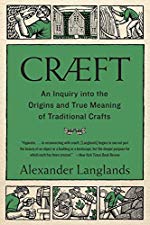Cræft
November 23, 2019 7:43 PM - by Alexander Langlands - Subscribe
Faced with an endless supply of mass-manufactured products, we find ourselves nostalgic for goods bearing the mark of authenticity―hand-made tools, local brews, and other objects produced by human hands. Archaeologist and medieval historian Alexander Langlands reaches as far back as the Neolithic period to recover our lost sense of craft, combining deep history with detailed scientific analyses and his own experiences making traditional crafts. Craft brims with vivid storytelling, rich descriptions of natural landscape, and delightful surprises that will convince us to introduce more craft into our lives.
I agree except for the cræft part. I’m willing to allow the author that affectation, if only to make the book stand out on a shelf.
But yeah, he often oversells the value of a traditional craft as being substantially or even strictly superior to the modern method, when it would suffice to argue that these crafts are worth preserving as cultural heritage and (in many cases) artistry, independent of their direct economic value as means of production.
And I say that as someone with a very (pardon me) cræfty hobby, hand tool woodworking. I would never argue that it’s superior to power tool woodworking for production work or even for a lot of bespoke work. For me its value is in the pleasure of skilled labor, a combination of physical mastery and mental problem solving, and the connection to the process and materials that gets lost in a powered, assembly line production.
posted by jedicus at 12:15 PM on November 24, 2019 [2 favorites]
But yeah, he often oversells the value of a traditional craft as being substantially or even strictly superior to the modern method, when it would suffice to argue that these crafts are worth preserving as cultural heritage and (in many cases) artistry, independent of their direct economic value as means of production.
And I say that as someone with a very (pardon me) cræfty hobby, hand tool woodworking. I would never argue that it’s superior to power tool woodworking for production work or even for a lot of bespoke work. For me its value is in the pleasure of skilled labor, a combination of physical mastery and mental problem solving, and the connection to the process and materials that gets lost in a powered, assembly line production.
posted by jedicus at 12:15 PM on November 24, 2019 [2 favorites]
I enjoyed this book - I like the confessional polemic as a genre - but man the author can be infuriatingly glib. The weaving chapter (near and dear to me) is a good example - dude wants to talk about wattle hurdles, that’s cool, but he feels the need to justify that by claiming that weaving *derives from* hurdles? Come on. We have direct evidence of weaving from early Neolithic - 6000bce- same as the earliest surviving mats. Yes, probably interlacing stiff materials preceded interlacing floppy ones, for logistical reasons, but there isn’t any surviving evidence to prove it, or suggest a large gap between the two. Especially when humans had twisted yarn/twine at least another 7k years earlier, maybe as far back as 20k bce.
Frankly it read to me as a desire to spend his attention on more masculine-coded aspects of craft. Otherwise he might also have even briefly acknowledged any of the approaches to garment construction and embellishment - patternmaking, draping, sewing, knitting and crocheting, tatting, bobbin-lace, embroidery, netting, (and for completeness and because I am obsessed lately: sprang), which mostly all have a thousand years+ as “traditional crafts”. (Sprang goes back to the Neolithic! Obsessed!)
Even the chapter on shoes and harness only gets into leather and tanning (and horse breeding), but not the sewing which is critical.
Dude can write the book he wants to write, but maybe own up to the narrowness?
Still, I enjoyed reading this. I learned interesting things, although I am suspicious enough not to take his account as necessarily complete or accurate. And maybe he was trying to rouse the warm glow of mild outrage?
posted by janell at 10:36 PM on November 25, 2019 [3 favorites]
Frankly it read to me as a desire to spend his attention on more masculine-coded aspects of craft. Otherwise he might also have even briefly acknowledged any of the approaches to garment construction and embellishment - patternmaking, draping, sewing, knitting and crocheting, tatting, bobbin-lace, embroidery, netting, (and for completeness and because I am obsessed lately: sprang), which mostly all have a thousand years+ as “traditional crafts”. (Sprang goes back to the Neolithic! Obsessed!)
Even the chapter on shoes and harness only gets into leather and tanning (and horse breeding), but not the sewing which is critical.
Dude can write the book he wants to write, but maybe own up to the narrowness?
Still, I enjoyed reading this. I learned interesting things, although I am suspicious enough not to take his account as necessarily complete or accurate. And maybe he was trying to rouse the warm glow of mild outrage?
posted by janell at 10:36 PM on November 25, 2019 [3 favorites]
You are not logged in, either login or create an account to post comments

posted by Homo neanderthalensis at 7:52 PM on November 23, 2019 [7 favorites]